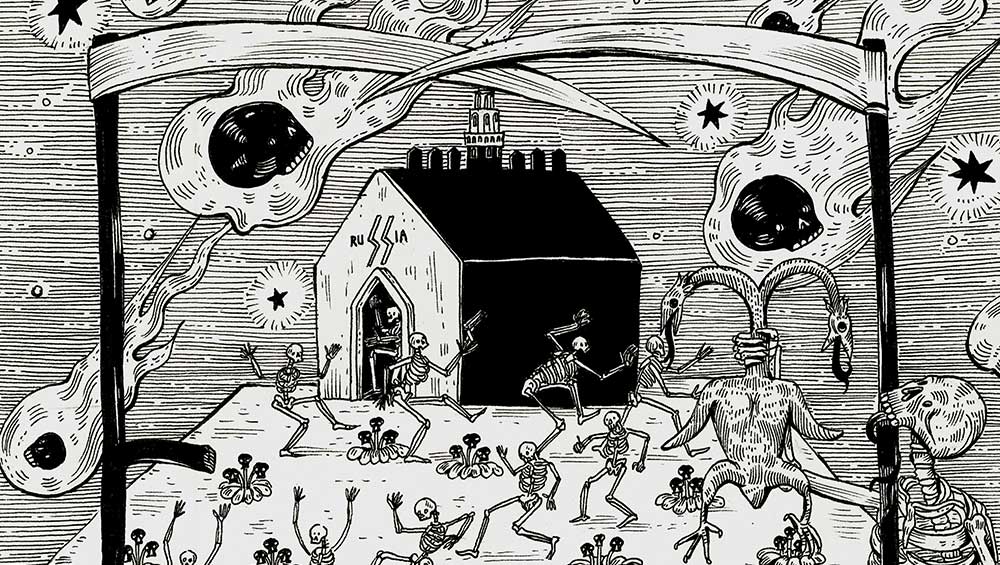
Ave Libertatemaveamor, Queue, 2022 (detail). Paper, liner, marker, 24 x 31.4 cm. © the Artist.
by JANET McKENZIE
The Australian artist George Gittoes (b1949) and the Ukrainian artist Ave Libertatemaveamor (b1989), who grew up in western Ukraine and studied at the National Academy of Fine Arts and Architecture in Kyiv, have collaborated on two important works: a mural entitled Kiss of Death (2022-23) and a graphic novel of the same name. Gittoes discovered the work of the young Libertatemaveamor when it was exhibited in Odessa, and he identified with her surreal insect drawings. They met in Kyiv, where they worked during 2022-23 to rebuild the bombed House of Culture in Irpin.
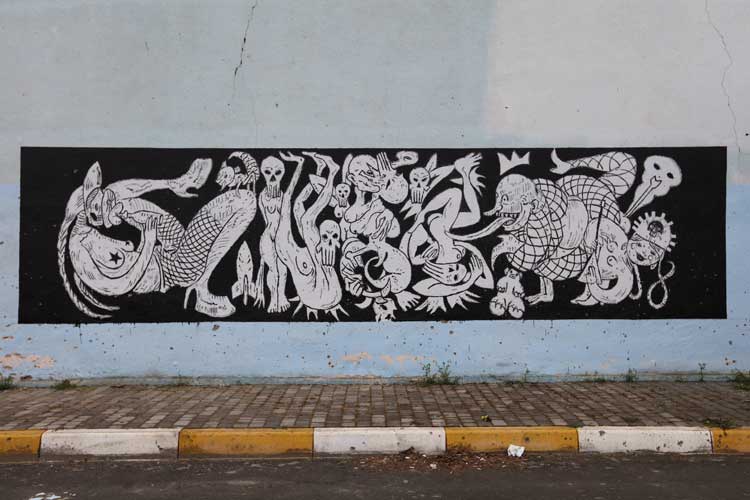
George Gittoes, Warhouse mural, Central House of Culture, Irpin. 2023. © the Artist.
The mural Kiss of Death, on the outside wall of the House of Culture, just 21km (13 miles) from Kyiv, was conceived as a symbolic gesture to lead a campaign to restore peace and normality after the destruction of 70% of the city. Similar in size and in graphic black and white, the mural conjures Picasso’s Guernica in the minds of the locals and is greatly appreciated. The drawing, composition and figurative subject elements depart from Guernica in not portraying anguished humans and animals as casualties of war. Instead, it refers to Vladimir Putin’s relationship with Alina Kabaeva, a retired Olympic medal-winning gymnast who is known as the “most flexible woman in Russia”. Kiss of Death, the mural and now the graphic novel, refers to Putin’s reprehensible political and personal life.
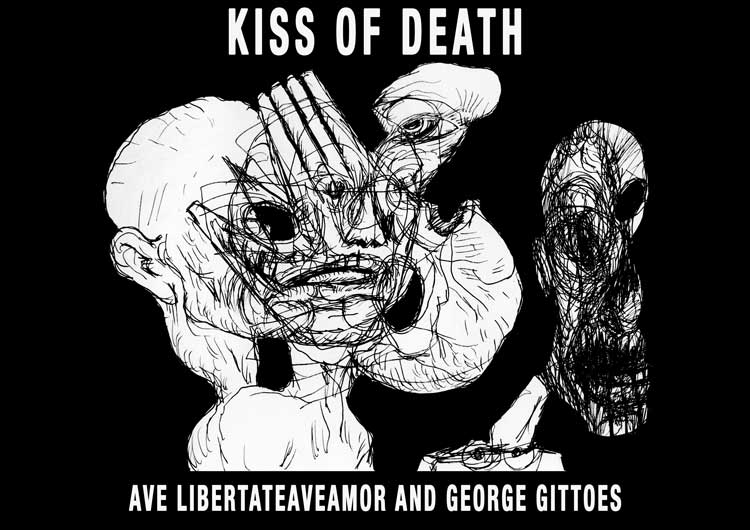
Ave Libertatemaveamor and George Gittoes, Kiss of Death. Book cover.
The comic book Kiss of Death comprises 60 drawings by each artist. The daily drawings were begun in 2022, after Russia’s invasion of Ukraine, and during this time, Ave gave birth to her first child. Gittoes recalls: “Since our first meeting, in April 2022, she and I have created a new drawing every day and shared them via the internet or in person. Like Banksy, Ave uses a false name and hides her face from the cameras in order not to reveal her true identity. She brought out the surrealist in me, insisting that we work as much as possible from the subconscious. The mural was to be a high point in our collaboration. We were excited to combine elements of our drawings into a major composition for the outside of the symbolic building. On this, an amplified scale, the local population could feel that art was coming back, like a phoenix out of the destruction.”
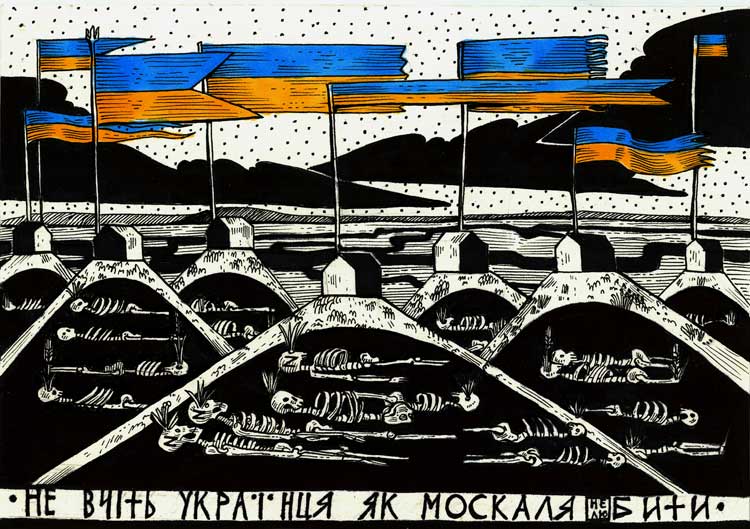
Ave Libertatemaveamor, Don't teach a Ukrainian like a Muscovite not to love, or Don't teach a Ukrainian to beat a Muscovite, 2022. Paper, liner, marker, 18 x 12.5 cm. © the Artist.
The collaboration between Gittoes and Ave is underpinned by their respective practice of keeping visual diaries. Kiss of Death takes Ave’s practice of doing every day at least one black-and-white ink drawing on 18 x 12.5cm paper sheets. They exchanged their images daily by email. Gittoes describes their project as “the most intense and productive collaboration of his career”. Ave, he says, “has reminded me of the importance of drawing in a small format. It gives a greater freedom for subconscious expression. When working on larger sheets of paper or canvas, there is an inhibiting factor where the output is taken too seriously.”
Kiss of Death, the graphic novel, was launched in Melbourne in August 2023: 120 drawings without text are presented as a subconscious history of the war.
Ave Libertatemaveamor spoke to Studio International from Kyiv via email.
Janet McKenzie: Can you describe your collaboration, Kiss of Death, with George Gittoes.
Ave Libertatemaveamor: Working with George Gittoes and Hellen Rose [a singer and performer and the wife of Gittoes] has been a gift of fate. Almost from the first days of the war, I began to depict my reaction to events. It helped me to not feel helpless in this situation. Fortunately, it turned out to be useful, if only because the works became one of the voices that spoke about the atrocities of the Russians in Ukraine. George came across my works at a platform in Odessa where Ukrainian artists’ posters were displayed, organised by the curator Volodymyr Uma.
For me, working with these beautiful people was very natural, interesting and inspiring. We exchanged our works in correspondence: there were quite a lot of them, and George offered to make a book. I was more than in favour of this wonderful idea. It is an honour for me. The mural was also George’s idea, its composition and organisation. I was surrounded by limitless comfort in working on it. I remember our collaboration with great gratitude.
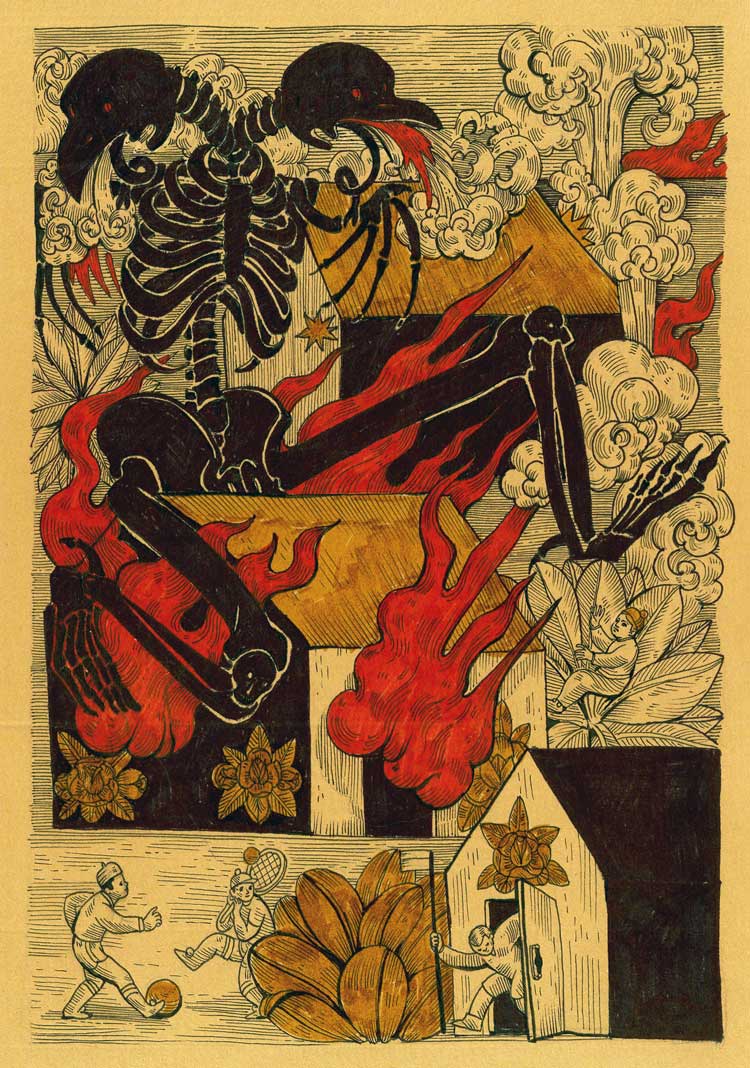
Ave Libertatemaveamor, Beast, 2022. Paper, liner, marker, 21 x 29.7 cm. © the Artist.
JMcK: Drawing is pivotal to your practice and the most powerful and direct form of expression. Can you explain the role of drawing in your art practice?
AL: I adore music, literature, painting and sculpture as important forms of self-expression, but a graphic language is the best for me, probably because the tool is fast, clear and does not tolerate editing. It is convenient, compact and does not require special preparation, so it can be practised anywhere and anytime.
JMcK: What were you doing when Vladimir Putin invaded Ukraine?
AL: First, I want to point out that it was Russian citizens who invaded, dropped bombs, committed violence, robbed, raped and maimed Ukrainians. They supported, justified and silenced the crimes of their government. If we formulate the thesis that Putin attacked Ukraine, then it is only on the condition that Russia is a collective Putin.
We were in Kyiv at the beginning of the invasion. We were woken up by explosions. In 10 minutes, we grabbed our backpacks and our sick 17-year-old dog. Then we picked up my husband's mother and drove west. It was impossible to comprehend the reality. It was apocalyptic. We spent two months with my parents, and then returned to Kyiv.
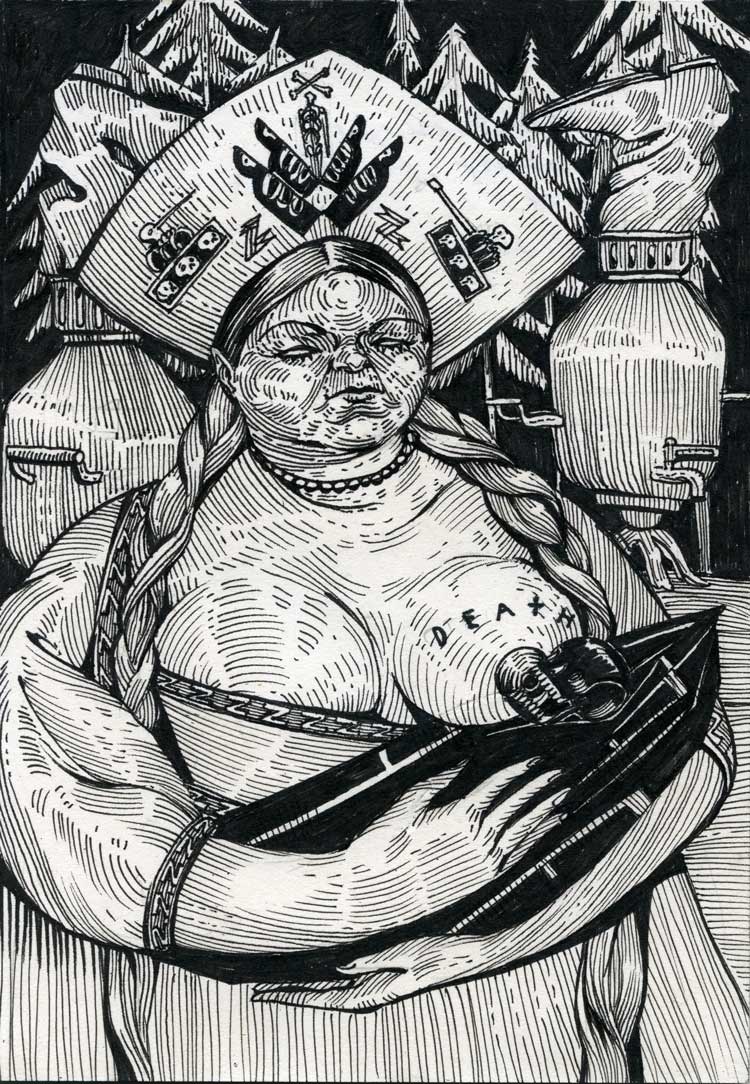
Ave Libertatemaveamor, Wet-nurse, 2022. Paper, liner, marker, 12.5 x 18 cm. © the Artist.
JMcK: Does making art assuage the appalling reality of destruction that surrounds you?
AL: I think drawing has always been therapy for me. But if before, it was a personal territory, an island in the subconscious where one could hide from objective reality, now reality cannot be ignored. War requires conscious reactions.
JMcK: Your work is often dreamlike and draws on the subconscious. Have you always made this type of graphic work?
AL: Very precise wording: six years ago, I decided to speak exactly like this in my work. Ave is an abbreviation, where E is Eam, an island in the subconscious, where events take place. Eam translates from Latin as it or her, which is a reference to Freud’s id. This is a symbolic documentation of the process of answering the questions I ask myself, trying to find the original source.
As for dreams, in my opinion, they are a symbolic notification of one part of the brain to another, a system of subconscious analysis and notification. When I think of something, it comes as an image and emotion in my head, and I write it down.
JMcK: Your insects are very menacing and unsettling. What do they signify?
AL: Probably subconscious horror. Insects are equipped with incredible adaptive defence mechanisms. And it is very scary to imagine these creatures being our size, or larger.
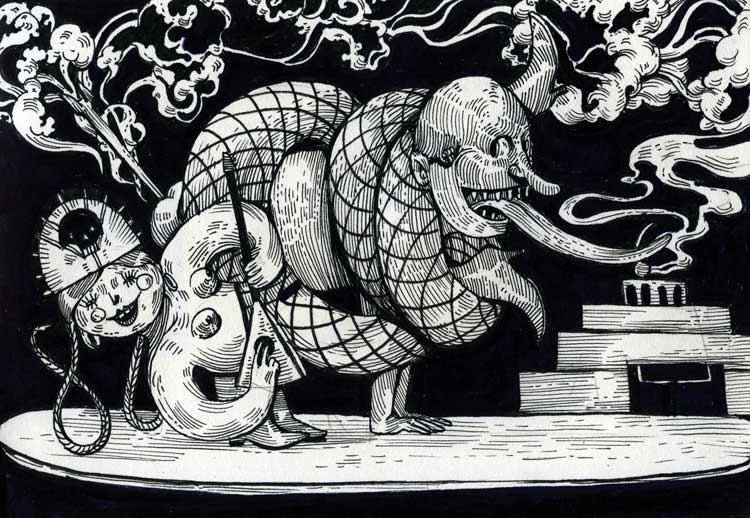
Ave Libertatemaveamor, Russian Love Story, 2022. Paper, liner, marker, 18 x 12.5 cm. © the Artist.
JMcK: Did you and other Ukrainian citizens expect Russia to make the devastating unprovoked attack?
AL: I think it was very much felt, the air was electrified as if before a thunderstorm, but I did not want to believe, or accept that such a course of events would happen. We were preparing, we had a plan of action, my husband was confident, but I didn’t want to accept such a truth until the end. Probably, as far as I can tell, the majority were like me.
JMcK: Do you have family nearby in Kyiv? How has the war impacted their lives?
AL: My husband’s mother is in Kyiv. Already three rockets or debris have fallen near her house, the last one hit a residential building 30 metres away. My husband’s sister’s house was temporarily destroyed at the beginning of the war: it was located near Gostomel. While Russian tanks were driving through their streets, she and her husband, their seven children and their sick parents lived in the basement for two weeks without electricity, heating or water. Now, fortunately, she is with her younger children in Germany.
My husband’s cousin, Mykhailo Medvedsky, was wounded on Hrushevsky Street during the Maidan Square protests in 2014. After that, he went to Donbas as a volunteer, when Russian and pro-Russian groups seized power. The war in Donbas was officially called the Anti-Terrorist Operation (ATO). He fought hard there for Ilovaisk, and was captured and tortured by the Russian military. Eventually, he was released under an exchange and underwent a long period of rehabilitation. Since then, he has married and now has four children. In the winter of 2022, the war caught them in Kyiv where he and his wife, Yulia, their younger children and mother survived a difficult winter near Kyiv. Helicopters near the windows forced Mykhailo and Yulia to move to a village near Kyiv, where his mother (my husband’s aunt) lives. They spent the winter there. Mykhailo was in the territorial defence forces of the Ukrainian armed forces), engaged in patrolling. Now they are back in Kyiv.
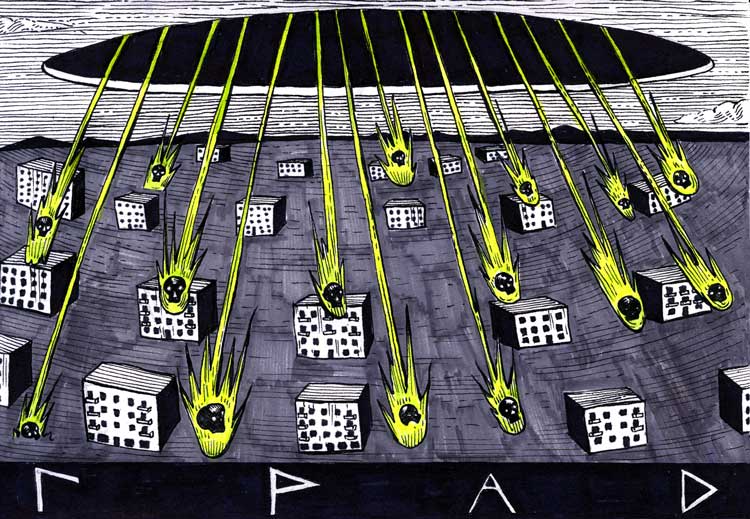
Ave Libertatemaveamor, Grad or Hail, 2022. Paper, liner, marker, 18 x 12.5 cm. © the Artist.
JMcK: Can you explain what it is like for someone of your generation in Ukraine to experience the horror of war? And you have given birth to your daughter since the war began?
AL: It seems to me that an effective fight against Russian colonialism in our country became possible just when the generation born in free Ukraine grew up. We do not understand why our neighbour wants to decide what kind of life we should live, what to think and what to want.
The war forces you to grow up quickly, to be responsible for those around you, to appreciate the moments of closeness, happiness and joy, and the birth of a daughter multiplies this and adds an infinite amount of love every minute.
JMcK: Who are the artists and art that you most admire, historically?
AL: I adore Ernst Haeckel. His book Art Forms in Nature (1904) is an extraordinary work that combines scientific classification and artistic vision: an incredible view of life. And, of course, I love medieval household engraving.
JMcK: Who are the living artists you are influenced by?
AL: I follow most of the contemporary Ukrainian artists; we all influence each other in some way, to some extent. However, the way George Gittoes works, how art has grown into his life and what it produces, is admirable. After meeting the incredible couple Hellen and George, I realised how little I do to live art. When they are around, Ave’s world experiences springtime.
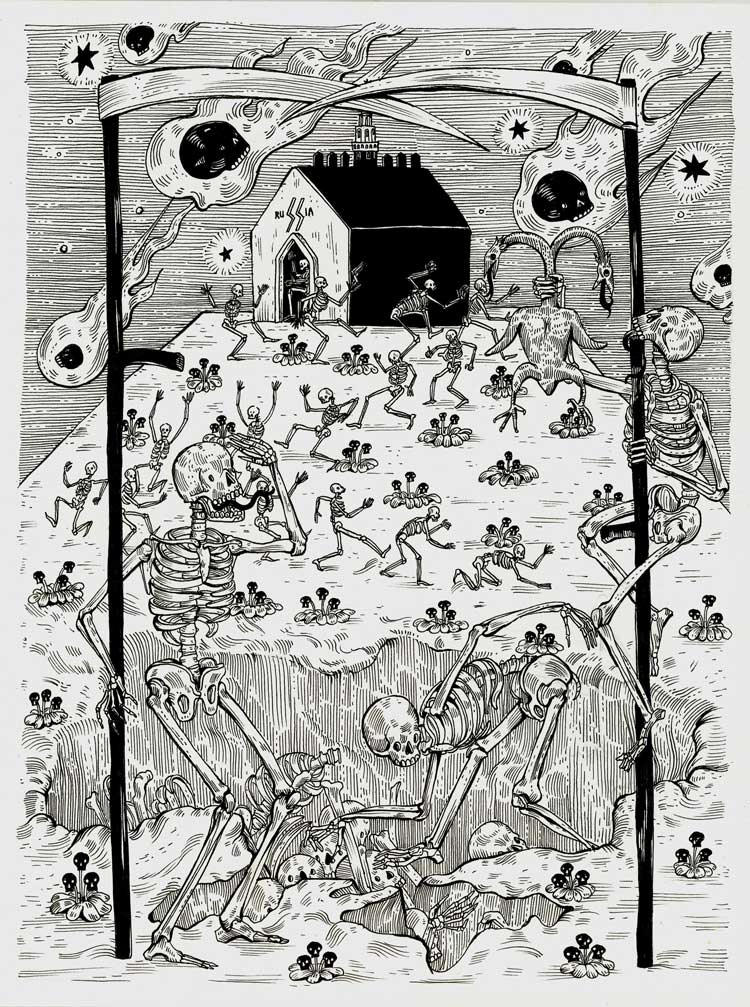
Ave Libertatemaveamor, Queue, 2022. Paper, liner, marker, 24 x 31.4 cm. © the Artist.
JMcK: Can you explain what the two images on page 65 of Kiss of Death represent?
AL:The first image is Queue, a kind of macabre, from a house marked with Zs, which are inverted in a certain way, reminiscent of the Nazi SS marking, a queue of suicides in the form of the letter Z, burying itself in a pit in the shape of Ukraine. The second is Solntsepek. This is the name of a heavy flamethrower that launches 220mm calibre shells. The name of the weapon translates as “burning sun”. This is about Russia for ever changing the meaning of words that will have a tragic context for a long time.
JMcK: Images of Hell in art are often metaphors to express the horror of war. Do you feel a powerful connection with artists who have gone before you? Hieronymus Bosch or Goya, for example?
AL: Of course, contemplating the actions of the Russians helps me to be more sensitive to infernal images. Cruelty is always the same.
JMcK: George Grosz highlighted the impact of war on the individual by portraying himself as a survivor navigating through the remains of his destroyed homeland. Does your work seek this end?
AL: The concept of the existence of Ukraine, in my opinion, has always been connected with the struggle for freedom. And as practice shows us, the darkest pages of our history were when we lost our identity, not our houses. The more we are destroyed, the more we remember who we are. Unfortunately, the image resembles a deal with the devil, gainingprivileges of freedom, we forget its value and essence. Such a prospect is frightening, but I am an optimist, or a dreamer.
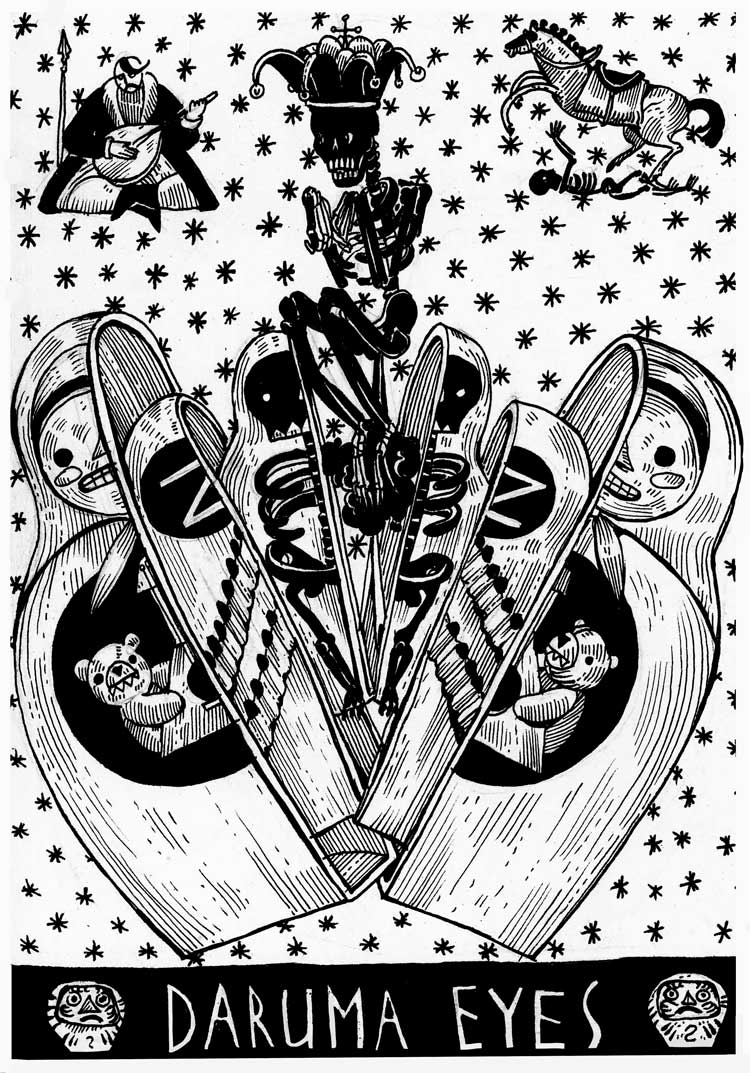
Ave Libertatemaveamor, Daruma’s Eyes 2022. Paper, liner, marker, 18 x 12.5 cm. © the Artist.
JMcK: In your drawing Daruma’s Eyes, what do the Russian dolls signify?
AL: The work is about the superficial, devalued borrowing of cultural symbols and their triumphant return to their origins. Daruma is a traditional Japanese doll that is a symbol of achieving goals. At first, Daruma’s eyes are white; then, when the owner chooses a goal, he draws the left eye, and after achieving the goal, he draws the right eye. The image shows that the goal has been achieved, the doll is split; in the middle is the hero of Russian folklore, Koshchei the Immortal, who met his death on a needle. Above him sits the hero of our folklore, the Cossack bandurist Mamai with his faithful horse.
JMcK: So many people fled the war and left Ukraine. Did you also consider leaving?
AL: I thought about it when I read about the horrors of the second world war, but when the time came, I could not leave the country. Everything I value is here. But to be fair, I’m tentatively safe, thanks to our incredible defenders.
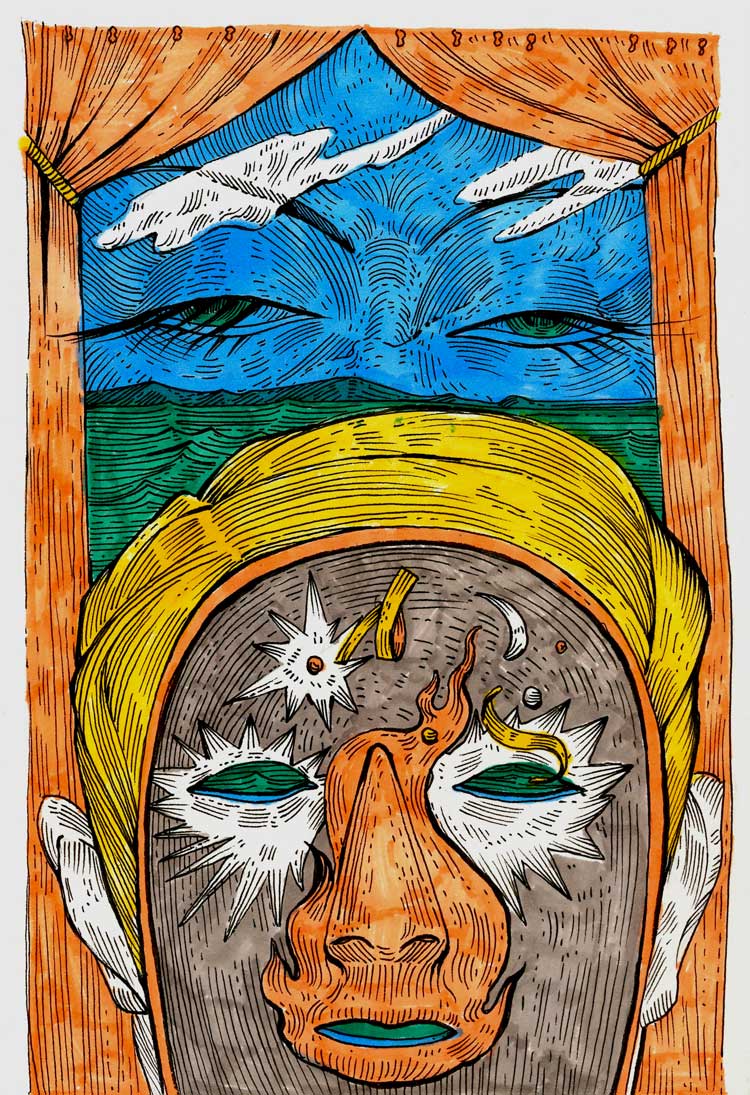
Ave Libertatemaveamor, Falling in love, 2022. Paper, liner, marker, 12.5 x 18 cm. © the Artist.
JMcK: You are the mother of a baby born during the war. This must seem an intolerable collision of the joy of motherhood and having to survive the dangers of war. Can you describe your day-to-day life?
AL: Well, I have nothing to compare it with. We are very lucky to have such a beautiful fragile person as Penelope as our life companion. She makes you want to love and appreciate life, because you want to spend more quality time with her and find the right words to justify the place she got to because of us. During the day, we do various things together. She likes to make sounds from different musical instruments and explore everything around her. Her inner strength, with which she trains every day to learn the movements we are used to, her means of communication is inspiring. I draw at night. When the alarm sounds, we go into the corridor. The explosions unite us, because we all hug, trying to protect Penelope, the dog and each other.
JMcK: Your antiwar art is very courageous. Can you explain how you have become the artist you are today?
AL: I do not see anything special in my work today; I am an ordinary Ukrainian trying to understand the new reality.
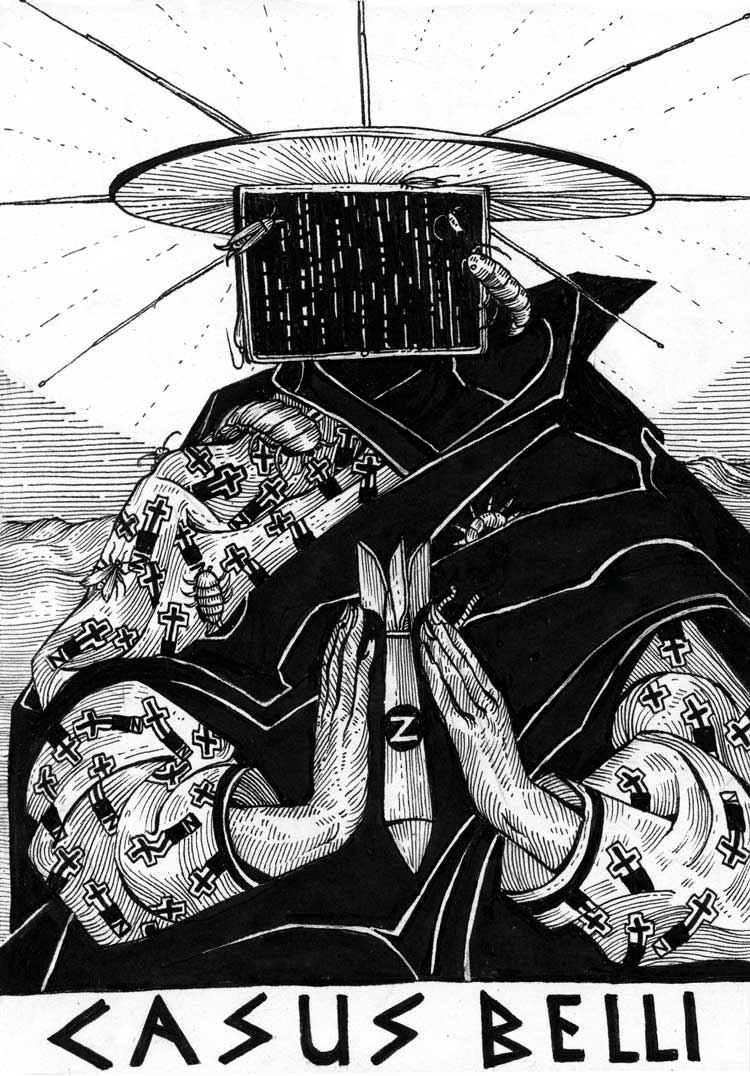
Ave Libertatemaveamor, Casus Belli, 2022. Paper, liner, marker, 12.5 x 18 cm. © the Artist.
JMcK: Casus Belli and Motanki (on page 18 of the book) seem to be a combination of a history painting, a traditional woodcut and science fiction. Can you explain the enigmatic theatrical imagery?
AL: Саsus Belli is an image of the traditional values of Russians, which carries a change of concepts. This kind of sacralisation of mass murder, bloodthirstiness and thoughtlessness, in my opinion, became the reason for the war for ordinary Russians. The image of the saint, characteristic of icon painting, is covered with insects feeding on decay, with a nimbus of antennae, and the face is a television screen, with hands folded in a symbolic gesture of prayer, holding a nuclear warhead. This is how I see the “great holiness of Russia”.
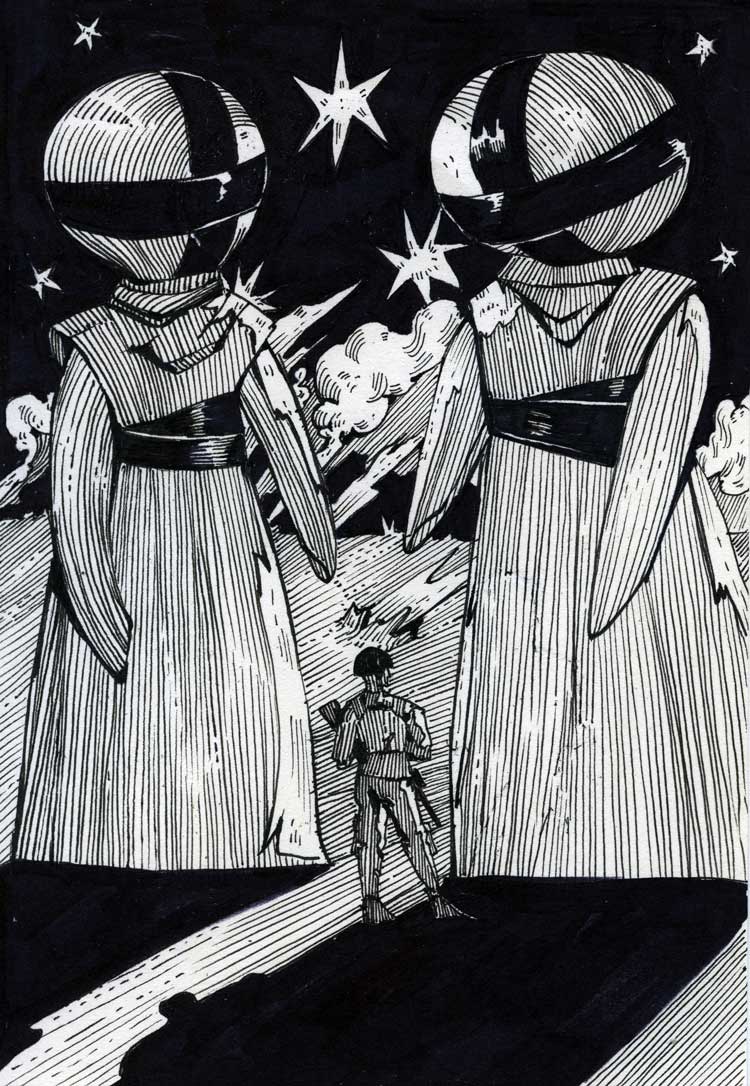
Ave Libertatemaveamor, Motanki, 2022. Paper, liner, marker, 12.5 x 18 cm. © the Artist.
Motanki are sacred dolls, talismans of ancient origin. They are, as it were, the personification of virtues and memories; they follow the soldier to protect his home and the children of his land.